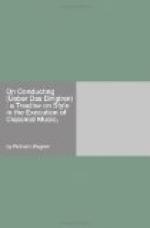We know that Haydn in his principal later symphonies used the form of the Menuet as a pleasant link between the Adagio and the final Allegro, and that he thus was induced to increase the speed of the movement considerably, contrary to the character of the true Menuet. It is clear that he incorporated the “Landler,” [Footnote: A South German country dance in 3/4 time, from which the modern waltz is derived.] particularly in the “Trio”—so that, with regard to the tempo, the designation “Menuetto” is hardly appropriate, and was retained for conventional reasons only. Nevertheless, I believe Haydn’s Menuets are generally taken too quick; undoubtedly the Menuets of Mozart’s Symphonies are; this will be felt very distinctly if, for instance, the Menuetto in Mozart’s Symphony in G minor, and still more that of his Symphony in C major, be played a little slower than at the customary pace. It will be found that the latter Menuet, which is usually hurried, and treated almost as a Presto, will now shew an amiable, firm and festive character; in contrast with which, the trio, with its delicately sustained
[music score excerpt]
is reduced, as usually given, to an empty hurry-skurry (eine nichtssagende Nuschelei). Now Beethoven, as is not uncommon with him, meant to write a true Menuet in his F major Symphony; he places it between the two main Allegro movements as a sort of complementary antithesis (ein gewissermassen erganzender Gegensatz) to an Allegretto scherzando which precedes it, and to remove any doubt as to his intentions regarding the Tempo he designates it not as a Menuetto: but as a Tempo di Menuetto. This novel and unconventional characterization of the two middle movements of a symphony was almost entirely overlooked: the Allegretto scherzando was taken to represent the usual Andante, the Tempo di Menuetto, the familiar “Scherzo” and, as the two movements thus interpreted seemed rather paltry, and none of the usual effects could be got with them, our musicians came to regard the entire symphony as a sort of accidental hors d’oeuvre of Beethoven’s muse—who, after the exertions with the A major symphony had chosen “to take things rather easily.” Accordingly after the Allegretto Scherzando, the time of which is invariably “dragged” somewhat, the Tempo di Minuetto is universally served up as a refreshing “Landler,” which passes the ear without leaving any distinct impression. Generally, however, one is glad when the tortures of the Trio are over. This loveliest of idylls is turned into a veritable monstrosity by the passage in triplets for the violoncello; which, if taken at the usual quick pace, is the despair of violoncellists, who are worried with the hasty staccato across the strings and back again, and find it impossible to produce anything but a painful series of scratches. Naturally, this difficulty disappears as soon as the delicate melody of the horns and clarinets is taken at the proper tempo; these instruments are




